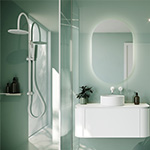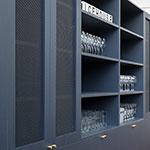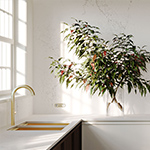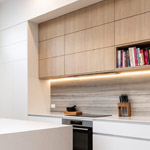All you need to know to transform your space with Surround by Laminex.
One of the simplest ways to elevate your home or office interior is with decorative architectural wall panels. Surround by Laminex is a stylish tongue-and-groove panel system that can be easily installed by any DIY enthusiast. With just a few basic tools and the tips below, you’ll be able to quickly transform a plain room into one with personality and style.
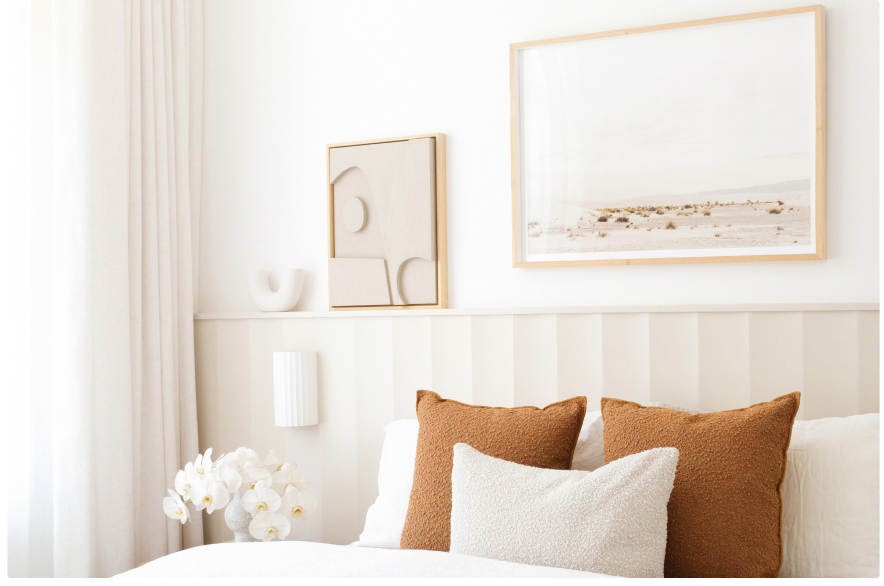

What are Surround by Laminex interior wall and ceiling panels?
Surround by Laminex are a modern range of durable, profiled MDF panels that fix directly to interior walls and ceilings. They have a flat back face made of low-pressure melamine (Classic VJ 100 comes with a raw MDF back face) for easy installation and a decorative front face that is pre-primed for painting. Surround by Laminex is also available as an FR MDF substrate. Both Scallop 45 and Batten 25 are available as an FR MDF substrate in the larger sheet size of 3000 mm x 1200 mm.
What are the sheet sizes?
All panels come in a nominal size of 2400 mm x 1200 mm or 3000 mm x 1200 mm. Classic VJ 100 has a 9 mm thickness, the rest of the profiles are 12 mm thick. The six profile designs offer a range of pattern widths:
- Batten 25: 25 mm
- Classic VJ 100: 100 mm
- Demi Round 40: 40 mm
- French Stripe 30: 30 mm trough, 30 mm batten
- Scallop 45: 45 mm
- Scallop 135: 135 mm
Surround by Laminex Profiles
Where can I install Surround by Laminex?
You can install Surround by Laminex in most interior spaces direct to timber or metal framing, or on a sound, suitable substrate – preferably plasterboard over timber or metal framing. It can also be applied to ceilings, with ceiling battens at maximum 400 mm centres. Ideal interiors include living rooms, entrances, offices, corridors, lobbies, bedrooms and studios. The only exception is interiors with high humidity. For more on where Surround by Laminex can and can’t be installed, together with detailed instructions, download our latest Installation Manual.
Can I use Surround by Laminex on curves?
Surround by Laminex can be curved and fixed to curved surfaces. The process involves creating a series of saw cuts (called kerf cutting) in the back of the panel. It is recommended that a qualified tradesperson undertakes this work. For more details on curving, see the Installation Manual.
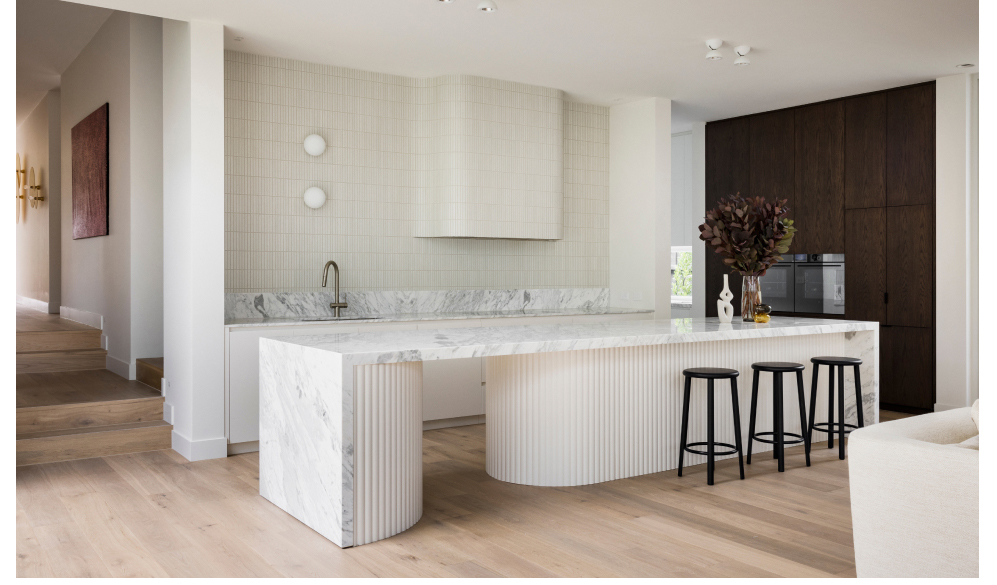

Which profile should I choose?
With a range of profiles from timeless vertical boards, to contemporary scallops, and soft undulating curves, there is likely to be a décor which ideal for your space and the look you are trying to create.
Profiles with a narrower pattern – such as Batten 25 or Scallop 45 – tend to work best on smaller wall areas, while the broader patterns – such as Classic VJ 100 and Scallop 135 – are more effective over larger expanses.
While the pattern is usually run vertically, you can install panels horizontally. Expansion gaps must be provided at sheet joins (please refer to the Installation Manual for details). The calm, wide spacings of profiles such as Classic VJ 100 work well horizontally.
What part of the wall should I start the installation on?
You can begin the installation at the centre of the wall or at one edge. We recommend the centre-out pattern: it requires a little additional work, but will ensure the panel widths are symmetrical at each corner. If this is not possible, start from one corner, and then work across the wall and trim the final panel to fit.
It is important that a fixing pattern be followed. The fixing should work from the centre of the panel out in every direction. If this is not possible on larger panels, fix along one side first and then work across the panel on all patterns evenly.
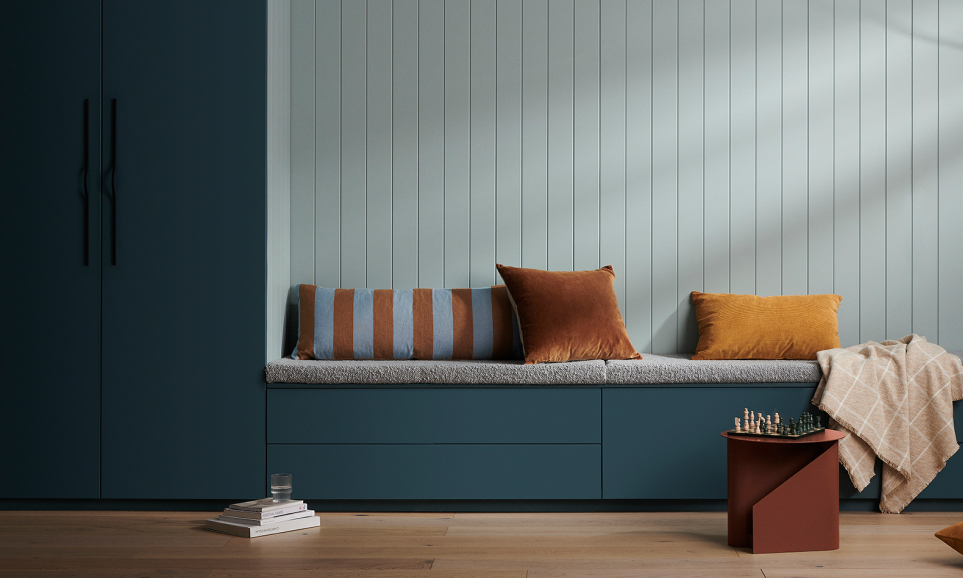

How many panels do I need?
Here’s how to work out the number of sheets you need:
- Measure the width/height of the area you intend to cover.
- Decide on the orientation of the panels.
- Divide the width/height by the width of the panel – 1200 mm (2400 mm or 3000 mm if installing horizontally) – to work out how many sheets you need to cover that area.
Then place your order with a merchant – see the Surround by Laminex web page for where to buy
Any quick tips before I start?
Before installation, Surround by Laminex panels need to acclimatise for a minimum of 48 hours on site. This will ensure panels reach equilibrium. You can use this time to ensure the wall is properly prepared, with clean, flat plasterboard.
Carefully measure the positions of any cut-outs (for power outlets, switches, etc.) and mark them on the sheets, so the outlets are accessible once the panel is fitted. It pays to spend time on getting this piece right to avoid any wastage.
Any internal corners or apertures should be made with a minimum internal radius of 10 mm. Cut-outs can be made with a router, or by pre-drilling a hole with an appropriate bit and then cutting between drill holes. Make sure you don’t locate any holes within 150 mm of a panel edge. If a switch or outlet is located within this border, then you’ll need to set the panels out differently or move the switch. Always ensure you involve a qualified electrician when working around power outlets.
How do I fix the panels?
Using a stud finder, locate each of the stud and nog positions behind the plasterboard, which are the solid fixing points you need for Surround by Laminex panels. Studs must be spaced no more than 600 mm apart. (If your wall requires more reinforcements, consult with qualified tradespeople to undertake any modifications.)
Apply a generous amount of construction adhesive in the location of each stud and nog, then position the panel on the wall. Use a spirit level to ensure the panel is accurately positioned, and use 5 mm spacers to create the expansion gap at the top and bottom (or edges when installed horizontally).
The panel can then be nailed by hand, nail-gunned, or screwed into place. Space the nails or screws 200–300 mm apart: 50 mm from the edge where possible, but not less than 5 mm, and no less than 5 mm from the top and bottom of the panel.
Then simply repeat the previous steps for each additional panel. Thanks to the tongue-and-groove system, you simply lock the panels together – there should be no need to force them together.
To finish the installation, cut the last panel to fit (remember to measure twice, cut once!), and then fix it into position. Once the panels are fixed to the wall, remove the spacers.
How do I finish Surround by Laminex panels?
Surround by Laminex panels are pre-primed with a water-based primer for top coating. Once all the panels have been fixed, use putty to fill in any nail or screw holes, allowing adequate drying time before you lightly sand and paint. Now is also the time to install skirting boards, mouldings, cornices and dado rails as necessary.
Using a medium-fine grit, lightly sand all surfaces to be coated for a smooth and even finish. To preserve the visual effect of the decorative profile, take care not to soften any profile edges by oversanding. Once sanding is complete, your wall is now ready to paint in the colour of your choice!
Surround by Laminex looks great in any colour, whether it’s a pale background colour or a bold accent. Your Laminex representative can provide samples, so you can test the visual effects of different colours and profiles in your space.
Please note this blog is intended as a Quick Guide only, depending on your installation, please make sure you follow all instructions detailed in the Fabrication and Installation Manual which can be downloaded here.
